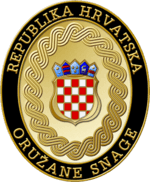Military of Croatia
| Armed forces of the Republic of Croatia Oružane snage Republike Hrvatske | |
|---|---|
|
Croatian Armed Forces emblem | |
| Service branches |
Croatian Army Croatian Navy Croatian Air Force and Defense |
| Leadership | |
| Commander-in-Chief | Kolinda Grabar-Kitarović |
| Defence Minister | Ante Kotromanović |
| Chief of staff | General Drago Lovrić |
| Manpower | |
| Military age | 18 years of age (voluntary) |
| Conscription | Abolished in 2008 |
| Available for military service | 835,712 (2008 est.), age 15–49 |
| Fit for military service | 671,323 (2008 est.), age 15–49 |
| Reaching military age annually | 48,500 (2008 est.) |
| Active personnel | 18,000~ (ranked 126th) |
| Deployed personnel |
|
| Expenditures | |
| Budget |
840 millionUSD 4.87 billion HRK [1] |
| Percent of GDP | 1.41% (2009) |
| Industry | |
| Domestic suppliers |
Đuro Đaković (armored vehicles) HS Produkt (small arms) |
| Foreign suppliers |
|
| Related articles | |
| History |
Military history of Croatia Ban Josip Jelačić Nikola Šubić Zrinski Croatian War of Independence Croatian National Guard War in Bosnia and Herzegovina |
| Ranks | Croatian military ranks |
Croatian military is officially called Armed Forces of the Republic of Croatia (Croatian: Oružane snage Republike Hrvatske - OSRH) and it consists of three branches:
- Croatian Army (Hrvatska kopnena vojska)
- Croatian Navy (Hrvatska ratna mornarica)
- Croatian Air Force and Defense (Hrvatsko ratno zrakoplovstvo i protuzračna obrana)
Strength
The total number of active military personnel in Croatian Armed Forces stands at 17,500 and 6,000 reserves working in various service branches of the armed forces.[2]
- Navy 2,000 personnel
- Air Force 2,000 personnel
- Army 12,500 personnel
- Croatian General Staff and units under its direct command 1000 personnel
Total available male manpower aged 16–49 number 1,035,712, of which 771,323 are technically fit for military service. Male citizens are now no longer subject to compulsory military service since January 1, 2008. However, the last generation of 2007 servicemen was also absolved of compulsory service by an act from then Minister of Defense Berislav Rončević.[3]
Budget
The Croatian military budget for the past 6–7 years was kept below 2% of GDP, a vast difference from the 1990s when defense expenditure represented a major stake in Croatian Budgetary expenditure due to the Croatian War of Independence. For example, 1995 Croatian defense budget stood at 12.4 billion Croatian Kuna or just over 12% of GDP, which was also the highest defense expenditure ever.
Defense Expenditures in recent years (example years - source Croatian MOD);
- 2000: 4.768 bln HRK - 3.13% of GDP[4]
- 2001: 4.909 bln HRK - 3.01% of GDP[4]
- 2002: 4.659 bln HRK - 2.64% of GDP[4]
- 2003: 4.814 bln HRK - 2.54% of GDP[4]
- 2004: 4.102 bln HRK - 2.00% of GDP[4]
- 2005: 4.106 bln HRK - 1.87% of GDP[4]
- 2006: 4.200 bln HRK - 1.67% of GDP
- 2007: 4.630 bln HRK - 1.69% of GDP
- 2008: 5.350 bln HRK - 1.79% of GDP
- 2009: 5.111 bln HRK - 1.52% of GDP
- 2010: 4.811 bln HRK - 1.45% of GDP
- 2011: 5.119 bln HRK - 1.47% of GDP[5]
- 2012: 4.828 bln HRK - 1.45% of GDP
- 2013: 4.85 bln HRK - 1.41% of GDP[6]
- 2014: 4.55 bln HRK - 1.25% of GDP (projected)[6]
- 2015: 4.75 bln HRK - 1.21% of GDP (projected)[6]
Although the budget has been decreased from year to year, Croatian Armed Forces were able to maintain military readiness and to participate in major NATO exercises in Croatia and overseas.
A downsizing of armed forces has allowed for more funds to be allocated to modernization over past few years with an average of 1.6 billion kuna spent on modernization, infrastructure and construction of new facilities.[7][8]
Modernization, although sporadic has provided Armed forces with desperately needed new equipment, albeit insufficient quantities to maintain NATO levels, which should be remedied over coming years.
A long term modernization plan, 2013-2023 is yet to be published. But according to government Croatian Armed Forces are set to receive vitally needed new equipment, including a battalion of self-propelled howitzers, new infantry fighting vehicles, at least eight brand new helicopters and a squadron of fighter aircraft.
At the moment Croatian Air Force will keep 12 MiG-21bis fighter aircraft, which received a general overhaul in Ukraine in order to keep them operational for another 4 to 5 years.[7][8]
Petar Zrinski Military Academy
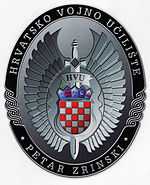
Petar Zrinski military academy acts as an school of higher learning responsible for training and educating future generations of military personal,. Academy consists of several schools, including "Ban Josip Jelačić"; "Blago Zadro"; "Katarina Zrinska"; The officer's Academy, and school for non commissioned officers. In all Academy at any time has 300 full-time staff and is only Military Academy in Croatia. Annually some 100-120 foreign nationals attend the academy.


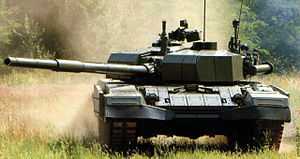
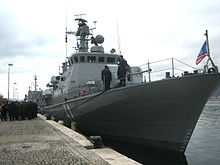
Commander
The Commander-in-Chief of all Croatian armed forces in peace and war is the President of the Republic. The Commander-in-Chief prescribes the organization of the Croatian Armed Forces at the proposal of the Chief of General Staff, with consent of the Minister of Defence.
The Armed Forces consist of peacetime and wartime component. The peacetime component is composed of active military officers, civil servants and employees in the Croatian Armed Forces, cadets, and conscripts serving a 6-month national service and reservists when on military exercise. The wartime component of the Armed Forces is additionally composed of all other reservists.
The General Staff is part of the Ministry of Defense in charge of commanding, training and use of the Armed Forces. It also has a number of units under its direct command, including the Special Operations Battalion, Honor Guard Battalion and several others.
In peace, the Commander-in-Chief exercises his command through the Minister of Defense. In war and in cases where the Minister of Defense is not fulfilling orders, the Commander-in-Chief exercises his command directly through the General Staff Commander.
The Croatian Parliament exercises democratic control over the Armed Forces by adopting defense strategy, defense budget and defense laws.
Special Forces and Honour Guard
Special Operations Battalion (Croatian: Bojna za specijalna djelovanja or BSD) was founded on September 8, 2000 with merging of the Special Combat Skills Center and some personnel from the 1st Croatian Guards Corps (1. Hrvatski Gardijski Zdrug). The Battalion has 300 men. Today, it is one of the most elite units of the Croatian military, as well as being one of the best trained and equipped special forces units in the region.[9]
The Croatian General Staff exercises direct command over the battalion which thus elevated the unit to strategic level for quicker reaction and overall better and faster tactical and strategic situations. Also, this means that members of all three branches of the Croatian armed forces can apply for selection.
Other special operations units are Military Intelligence Battalion (Vojno-obavještajna bojna or VOB) and Special Military Police Company (Satnija specijalne vojne policije or SSVP).
Duties of Honour Guard are performed by Počasno zaštitna bojna (300 men), located at Zagreb in Tuškanac military base.[9]
Projects
$3 Billion Kuna modernization plan proposed by than Ivica Racan SDP lead Government in 2003, with planned modernization starting in 2006 and ending in 2015 has been delayed due to subsequent economic recession, but also due to serious corruption that has cost Croatian MOD several billion kuna since 2006. A New Plan under current Prime minister Zoran Milanović should define exactly how and what Croatian armed forces should look like by 2023. Defence White paper should be published by the end of 2013 with emphasis placed on modernization of Army.
Proposed Defence Programs and updates/upgrades:
Army
- Procurement of 126 Patria AMV 8x8 Modular APC/IFV - 2.25 billion kuna (additional vehicles might be ordered after 2016) - All vehicles have been delivered so far with 115 Protector (RWS) remote stations delivered in two batches under $38 million contract. initial order for 8 out of 24 30mm RWS is yet to be made, contract is valued at some $55 million and includes 30mm RWs and 2 Javelin/or EuroSpike launchers.
- Procurement of 94 Iveco LMV (Light Multi-role Vehicles) at cost of 220 million kuna by late 2012. So far only 14 vehicles delivered without any indication if future 80 vehicles will be needed due to the fact that Army received over 200 new light armoured personal carriers from US.
- Procurement of advanced artillery systems, up to 18x 155 mm self-propelled howitzers are to be purchased before 2015 to replace obsolete 2S1 self-propelled howitzers, Croatian MOD is negotiating an order for 18 PzH2000 Howitzers with German Army, value of contract $36 million.
- Procurement of 550 5-ton army trucks, 200 7.5-ton military trucks and 300 4WD vehicles - program is in a full swing and first batch of MAN (150), Mercedes (30) and Iveco (50) military trucks was delivered. Croatian Army also ordered large numbers of new 4WD vehicles, Mercedes-Benz G-Class - 120, Land Rover Wolf - 60, Toyota Land Cruiser - 50, Nissan Navara - 50, got delivered in 2005-2007. Croatia is negotiating with Germany over purchase of 380 2nd hand army trucks of various sort, cost of program 40-50 million kuna.
- Modernization of M-84A and M-84A4 Snajper MBTs and upgrade to M-84D standard. Program is at standstill and is unlikely to receive further funding due to high costs involved of nearly 20 million kuna per tank, but overhaul of existing fleet might be completed by the end of 2017 at cost of 120 million kuna (24 vehicles already overhauled at cost of 60 million kuna).
- Introduction of new 5.56 mm NATO standard VHS assault rifle. Cost of program - 200 million kuna (20,000 rifles with day/night sights and grenade launchers)
- Scores of smaller programs, communication equipment, night vision capability, electronic sensors, NBC equipment, battlefield management systems and modernization of artillery systems with new sights and electronic fire control systems.
Air Force
- Procurement of Advanced short to medium range NATO SAM system, as of now no real funding has been mentioned other than project is a priority and current requirement calls for one battery although this might change in future as needs arise. estimated value - $50–70 million for new system or 2nd hand system might be a donation by US, in which case only VAT cost will be incurred.
- Procurement of short range SAM systems - no indication of what system or specifications other than range of up to 10 km and up to 3 batteries with one battery being ready by 2015/6. Total funding for this program hasn't been made public yet, but similar western systems tend to be in range of $17–20 million per battery.
- Overhaul of Mig 21 fighters - program is about to be completed at cost of 80 million kuna, 12 mig 21 fighters modernized and overhauled in Ukraine, at this point it was the cheapest alternative for Government which lacked funds for purchase of new fighters.
- Purchase of advanced fighter aircraft - medium to long term program, purchase of up to 18 4.5 generation fighters, program cost - 12-15 billion kuna (program is a long term investment in to air force next fighter with new fighters joining the Air Force around 2020 and after. Most likely candidates Jas 39E/F and F-16 E/F Block 60. Mig 21 fighters currently in service would no longer be able to be overhauled and thus extend life of their airframes due to the age and stress on the airframes, purchasing 2nd hand aircraft is still a possibility but with cost of 2nd hand fighters not far off from new fighters, it is not a feasible option.
- Purchase of up to 8 western made helicopters for SAR/Medevac and ASW as well as MP - cost of program not specified but preferences for EC135 Helicopter had been stated due to the fact that MUP recently purchased 2 such helicopters at cost of 50 million kuna for the two. Additional mission equipment might increase the cost for first 4 EC 135 helicopters, ASW/MR helicopters on the other hand might be a lot more expensive. Program cost First 4 helicopters 100-120 million kuna, Procurement of 4 additional ASW/MR helicopters won't be feasible before 2020, program cost for these 4 helicopters: $170–180 million if AS 565 are chosen.
- Purchase of replacement transport aircraft for An 32B. program is feasible after 2020 and would involve an purchase of 2-3 medium tactical transport aircraft, C27J and CN295 being most likely candidates. Program Cost: 550-580 million kuna for 2 aircraft, feasible only after 2020.
- Purchase up to 10-12 Transport Helicopters (after 2020) - replacing older Mil 8 and 17, cost of overhauling these was questioned if it was cost effective to continue overhauling these helicopters every few years instead of purchasing brand new western helicopter. With Government indicating that purchase of 10 new western helicopters might be the only option after 2020. Most likely candidates are NH90 or AS 532. program cost: 2.5 billion kuna. 10 Mil 171Sh will continue on in their service with Croatian Air force for at least another 20 years.
- Purchase of Unmanned aerial vehicles - no quantity specified but purchase will be made to enforce maritime zone and border controls as part of the EU Schengen Agreement which Croatia plans to join in 2015. Program cost: 100-120 million kuna, half financed by the EU.
Navy
Navy plans are still being worked on but present plans call for a medium expansion of the naval force.
- 10 new patrol boats, locally built, 42 meters in length. Cost of program 750 million kuna, or 375 million for first 5 ships, first to enter service in 2015, with remaining 4 in 2016 and 2017.
- 2 new corvettes - 80–125 meters in length. Cost of program 3.0 billion kuna. Program is at standstill due to lack of funds, feasible only after 2020.
- Overhaul of existing 2 King class fast attack crafts, including new engines. Cost of program - 40 million kuna. - 1 ship overhauled in 2010/11 and 2nd should be done in 2014.
- Upgrade of the RBS-15 missiles. - Cost of program - 120 million kuna. 24-32 missiles to receive an upgrade and overhaul by 2015/16 with remaining missiles being scrapped or sold.
- Overhaul of sea radar Falcon 2 Enhanced Peregrine - Program is being financed by US government at estimated cost of $8 million.
- Possible purchase of 2nd Minesweeper before 2020, although there are only indications of this might happen if funds can be allocated. Program cost - 80 million kuna.
Programs under revision
- BVP M-80A - Program is at a standstill and might no longer be an option. Croatian MOD stated that it will replace its M-80's with the modern western IFV when funds become available. Most likely contenders for this program are additional Patria AMVs in the IFV configuration.
Arms Exports
Croatian Arms exports.
Croatia as a small country has a relatively well developed arms industry that is highly competitive internationally with significant annual arms exports. In 2012, Croatia managed to export nearly €120 million.[10] However it has been reported in The New York Times that Croatia has been illegally arming Syrian rebels with Croatian manufactured arms used during the homeland war, arms Croatia no longer uses due to its obsolescence, but played a crucial role in some significant rebel gains during 2012.[11] As a result of arms sales Croatian government ordered immediate withdrawal of Croatian UN Golan Heights contingent.
in 2013 Croatia exported €143 million worth of arms,[12][13] however it is not clear if this also includes $36.5 million worth of illicit arms Croatia exported to Jordan for Syrian rebels. Croatia was the top supplier of arms to Syrian Rebels in 2013, but much of it through illicit channels and without Croatian Government approval or knowledge, much of arms were exported via Jordan.[14]
In 2014 Croatia arms exports have reached 1.5Bn HRK (Croatian kuna) or €200 million or $257 million, majority of exports being to NATO allies and Australia. In late 2014 Croatian Defence Minister announced major export deal to Iraq including State of Kurdistan, agreement includes sale of 20 000 VHS Rifles, 150 000 complete sets of uniforms, helmets and associated equipment valued at €100 million.[15] Croatian arms exports are growing steadily at 10-15% yoy, they're expected to reach 1.75 billion HRK in 2015 or around €230 million, although much of the equipment exported is non lethal Croatian firms have well positioned on some major arms tenders in middle east, supplying complex military hardware such as Patria AMV including newly developed 30mm overhead weapon station each valued at €1.25 million and said vehicles valued at €1.75 million. Kuwait, UAE and Saudi have been mentioned as potential customers although so far no concrete contracts have been signed, although Croatian firms are participating in Kuwaiti and UAE tender for next APC programs, each valued at billions of euros.
International cooperation
On April 1, 2009 Croatia joined NATO and on July 1, 2013 it became the 28th member of the European Union. The Croatian Armed Forces participate in many (military) aspects of both organizations as well as actively participate in many United Nations peacekeeping operations worldwide.
| Current Mission | Organization | Country | Nr. of personnel |
|---|---|---|---|
| United Nations Military Observer Group in India and Pakistan UNMOGIP | United Nations | India and Pakistan | 7 |
| European Union mission in Chad EUFOR Tchad/RCA | European Union | Chad | 15 |
| International Security Assistance Force - ISAF | NATO | Afghanistan | 321 |
| United Nations Mission for the Referendum in Western Sahara MINURSO | United Nations | Western Sahara | 3 |
| United Nations Mission in Liberia - UNMIL | United Nations | Liberia | 3 |
| United Nations Operation in Côte d'Ivoire UNOCI | United Nations | Côte d'Ivoire | 3 |
| United Nations Stabilization Mission in Haiti MINUSTAH | United Nations | Haiti | 3 |
| United Nations Peacekeeping Force in Cyprus UNFICYP | United Nations | Cyprus | 3 |
| Former Mission | Operation | Country | Organization | Nr. of personnel | Time |
|---|---|---|---|---|---|
| United Nations Observer Mission in GeorgiaUNOMIG | United Nations | Georgia | 3 | ||
| United Nations Mission of Support in East TimorUNMISET | United Nations | East Timor | 3 | ||
| United Nations Mission in Sierra Leone - UNAMSIL | United Nations | Sierra Leone | 10 | ||
| United Nations Mission in Ethiopia and Eritrea - UNMEE | United Nations | Ethiopia and Eritrea | 7 | ||
| United Nations Disengagement Observer Force - UNDOF | United Nations | Golan Heights - Syria and Israel | 95 | ||
| International military exercises | Country | Organization | Nr. of personnel | Time | |
|---|---|---|---|---|---|
| Noble Midas 2007 | 9000 | 2007 | |||
Gallery
-

Patria AMV
-
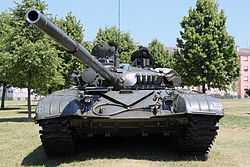
M-84A4 main battle tank
-
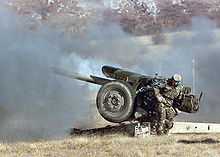
D-30 howitzer
-

Mi-171Sh
-

Croatian MiG-21 and US F-14
-

Wings of Storm aerobatic team
-
Bombardier 415
-
AirTractor AT-802A
-
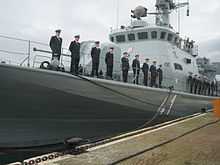
Helsinki class missile boat
-

Kralj class missile boat
See also
- Croatian military ranks
- Croatian War of Independence
- List of Croatian soldiers
- Military history of Croatia
- Military Security and Intelligence Agency
- Croatian Ministry of Defence
References
- ↑
- ↑ "Military Balance in Europe 2011"., March 07, 2011.
- ↑ Martina Čizmić (19 October 2007). "Nema više obveznog vojnog roka" [Compulsory military service abolished] (in Croatian). Nacional (weekly). Archived from the original on 1 July 2012. Retrieved 1 July 2012.
- ↑ 4.0 4.1 4.2 4.3 4.4 4.5 Alvir, Marija (March 2005). "Proračun MORH-a neće više padati". Hrvatski vojnik (in Croatian) (Croatian Ministry of Defence). Retrieved 9 September 2011.
- ↑
- ↑ 6.0 6.1 6.2 "NACRT PRORAČUNA - kupuje se Air Tractor za obuku i jedan ophodni brod do 2015.". Retrieved 24 December 2014.
- ↑ 7.0 7.1 http://www.hrvatski-vojnik.hr/hrvatski-vojnik/Hrv_pages/plannabave.asp
- ↑ 8.0 8.1 "HRT: MORH predstavio ostvarenje plana nabave za 2013. i plan za 2014.". Hrvatska radiotelevizija. 6 November 2013. Retrieved 24 December 2014.
- ↑ 9.0 9.1 http://www.morh.hr/katalog/documents/dpr_final.pdf
- ↑ http://www.novilist.hr/Vijesti/Hrvatska/Hrvatska-medu-25-najvecih-izvoznika-vojne-opreme-na-svijetu-lanjski-izvoz-880-milijuna-kuna
- ↑ C. J. CHIVERS;ERIC SCHMITT (25 February 2013). "In Shift, Saudis Are Said to Arm Rebels in Syria". Retrieved 24 December 2014.
- ↑ http://bosnian.irib.ir/vijesti/bih-i-region/item/160013-hrvatski-izvoz-oružja-blizu-143-miliona-eura
- ↑ "Croatian military output approaches USD1 billion". Retrieved 24 December 2014.
- ↑ "Hrvatska trgovala preko Jordana: Siriji prodano oružje vrijedno 200 milijuna kuna". Novi list online portal. Retrieved 24 December 2014.
- ↑ http://www.slobodnadalmacija.hr/Novosti/Hrvatska/tabid/66/articleType/ArticleView/articleId/273055/Default.aspx
External links
| Wikimedia Commons has media related to Military of Croatia. |
- Croatian Armed Forces Official website
- Croatian Forces International Volunteers Association official website
- - Defense planning and procurement.
- - long term planning and long term defense strategy
- Photos BSD
- CROMIL - Croatian military's official English-language magazine
| ||||||||||||||||||||||||||||||||
| ||||||||||||||||||||||||||||||||||||||||||
| ||||||||||||||
| ||||||||||||||||||||
